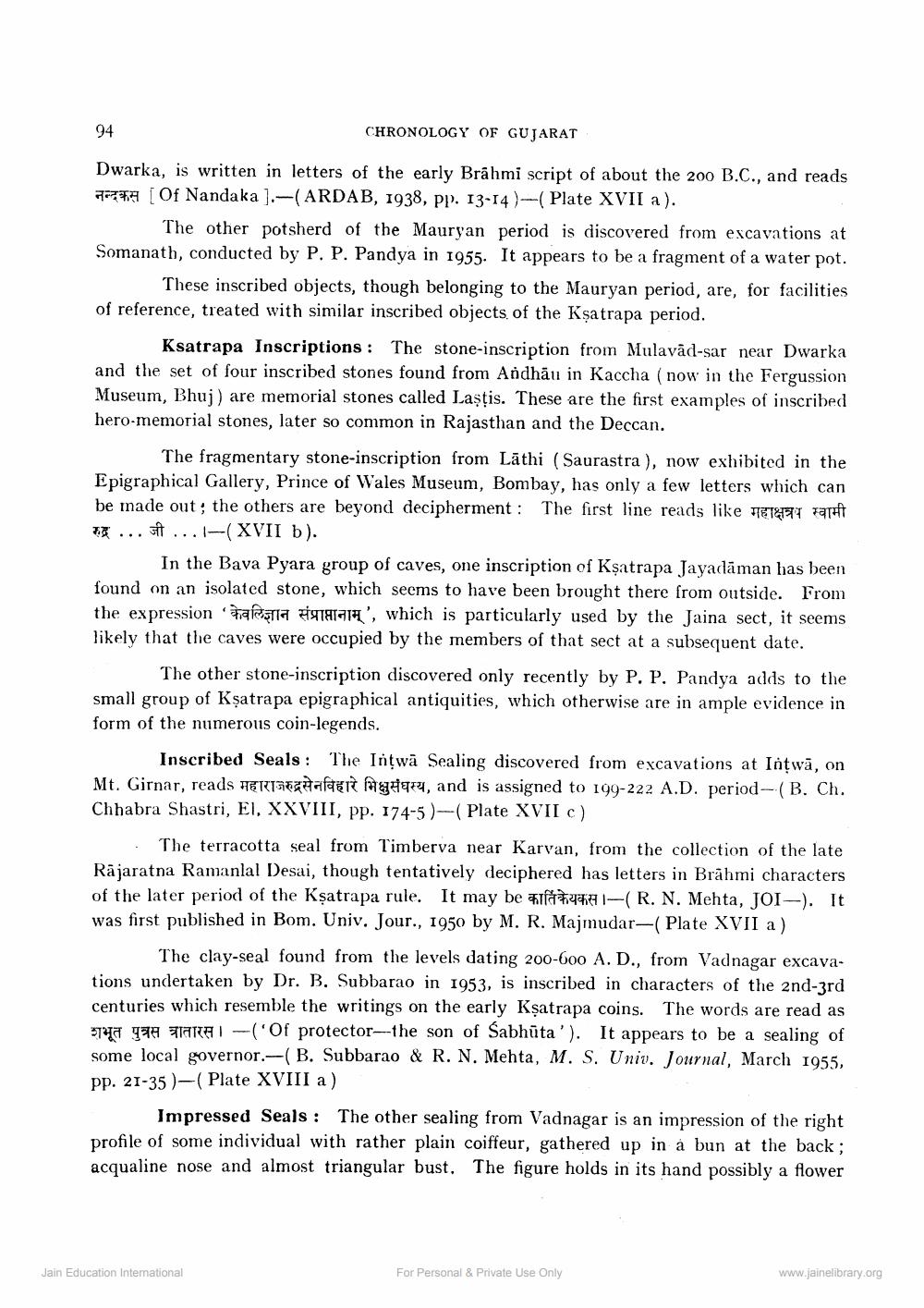________________
94
CHRONOLOGY OF GUJARAT
Dwarka, is written in letters of the early Brāhmi script of about the 200 B.C., and reads H277 [ Of Nandaka).-(ARDAB, 1938, PP. 13-14)-(Plate XVII a).
The other potsherd of the Mauryan period is discovered from excavations at Somanath, conducted by P. P. Pandya in 1955. It appears to be a fragment of a water pot.
These inscribed objects, though belonging to the Mauryan period, are, for facilities of reference, treated with similar inscribed objects of the Kșatrapa period.
Ksatrapa Inscriptions : The stone-inscription from Mulavād-sar near Dwarka and the set of four inscribed stones found from Andhāu in Kaccha (now in the Fergussion Museum, Bhuj) are memorial stones called Lașțis. These are the first examples of inscribed hero-memorial stones, later so common in Rajasthan and the Deccan.
The fragmentary stone-inscription from Läthi (Saurastra), now exhibited in the Epigraphical Gallery, Prince of Wales Museum, Bombay, has only a few letters which can be made out; the others are beyond decipherment: The first line reads like H1971 arift * ... ... 14(XVII b).
In the Bava Pyara group of caves, one inscription of Ksatrapa Jayadāman has been found on an isolated stone, which seems to have been brought there from outside. From the expressionaria tal', which is particularly used by the Jaina sect, it seems likely that the caves were occupied by the members of that sect at a subsequent date.
The other stone-inscription discovered only recently by P. P. Pandya adds to the small group of Ksatrapa epigraphical antiquities, which otherwise are in ample evidence in form of the numerous coin-legends.
Inscribed Seals : The Intwā Sealing discovered from excavations at Intwā, on Mt. Girnar, reads HERSE#afael H974, and is assigned to 199-222 A.D. period-(B. Ch. Chhabra Shastri, EI, XXVIII, pp. 174-5)--( Plate XVII c)
The terracotta seal from Timberva near Karvan, from the collection of the late Rajaratna Ramanlal Desai, though tentatively deciphered has letters in Brāhmi characters of the later period of the Ksatrapa rule. It may be at 4-(R. N. Mehta, JOI-). It was first published in Bom. Univ. Jour., 1950 by M. R. Majmudar-( Plate XVII a)
The clay-seal found from the levels dating 200-600 A. D., from Vadnagar excavations undertaken by Dr. B. Subbarao in 1953, is inscribed in characters of the 2nd-3rd centuries which resemble the writings on the early Kșatrapa coins. The words are read as 3747 a FanAI -(of protector--the son of Sabhūta'). It appears to be a sealing of some local governor.-(B. Subbarao & R. N. Mehta, M. S. Univ. Journal, March 1955, pp. 21-35 )-( Plate XVIII a)
Impressed Seals : The other sealing from Vadnagar is an impression of the right profile of some individual with rather plain coiffeur, gathered up in a bun at the back; acqualine nose and almost triangular bust. The figure holds in its hand possibly a flower
Jain Education International
For Personal & Private Use Only
www.jainelibrary.org




